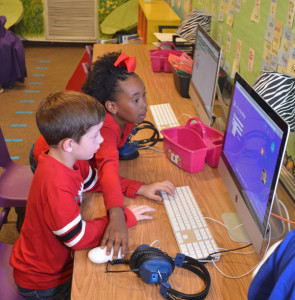
© 2015 by Steve Brawner Communications, Inc.
WARREN – Sutton Nelson is the type of high-achieving student who might be unchallenged in a traditional learning environment. The Warren School District is not traditional.
There, advancement is based on individual pathways and defined goals rather than the number of days spent sitting at a desk. Students advance through learning levels, not grades. Class time is often spent in small groups. All the students have a digital device, so they work side by side but often on different skills.
In that standards-based environment, students learn at their own pace. As a level 2 student – a first-grader – Nelson quickly advanced along her pathways, mastered the material, moved into level 3 and finished it. Now she’s a year ahead of schedule in level 7.
“It kind of like helped me,” she said. “‘Oh, I have more goals. I’m going to try to get this done and get good at this and know what I’m doing.’”
Schools traditionally measure student success based on averages, which means students can excel in some areas and struggle in others and still leave with a “A” or “B” – and with gaps in their knowledge. In Warren, students must demonstrate mastery of each skill before they advance to the next. While there are scheduled classroom tests, students often tell the teacher when they are ready to assess individually. Instead of receiving letter grades on that assessment, they receive scores of 1-4, with “3” indicating mastery and “4” representing exceptional understanding.
When they’ve reached a 3, they move to the next skill – but not before then. Or, they might move on and then return to that skill later. For example, a student stuck on fractions might proceed to decimals, which can help them better understand fractions.
The model enables students to advance as quickly as their skills and ambition will take them. When Nelson completes her pathways in high school, she can further her education by taking college or career-oriented classes while still in Warren. At age 18, she might walk across the stage with her friends and receive an associate’s degree.
Other students, meanwhile, can take the time they need to master each skill, rather than fall behind and never catch up because they never understood something important covered in week 3. If a student ends a year with pathways left to complete, they don’t flunk the entire year. Instead they can pick up that one skill after the school year ends or at the beginning of the next while remaining with their classmates.
As Regina Scroggins, principal at the elementary level Brunson New Vision Charter School, explained, “We no longer just look at test scores because you know, if you give a student an F, that’s it? Are they done forever? An F, they failed, they leave feeling stupid or like they’re never going to be successful. But this way with our personalized learning, they have another chance.”
Educators at Warren say this model gives students ownership of their education. Students are asking teachers if they can work on their goals during lunchtime, holidays and summer vacations.
It’s also helped parents become more involved. Report cards indicate mastery of individual skills rather than average scores by subject. So instead of seeing their child earned a “B” in math – probably good enough, right? – they know exactly what their children have and haven’t learned.
The transition has been “four years of rocky road,” said Carla Wardlaw, assistant superintendent. Among those rocks: The elementary-level East Side New Vision Charter School scored an “F” on the state’s recently created, test-based school report card, while Warren Middle School scored a “D.” (Warren’s two other schools scored a “B.”) East Side Principal Sara Weaver said Warren with its new teaching methods just doesn’t fit into the state’s box. Still, that “F” was a disappointment and perhaps an indication that the road may stay rocky a while longer.
The model undoubtedly is more work for the teachers. Level 3 teacher Elizabeth McKinney must plan the entire year from the beginning because her East Side students move at different speeds, and then she must instruct students individually rather than managing one big group. Still, she believes in the model.
“We started this because we felt like it was best for kids to learn at their own pace and in their own way, and so I’m all for it,” she said. “And I’ve told Miss Sara that if we ever went back to doing it the other way, I would revolt.”
Steve Brawner is an independent journalist in Arkansas. Email him at brawnersteve@mac.com. Follow him on Twitter at @stevebrawner.
I enjoy reading your columns Steve. Always looking forward to the next. Thanks!